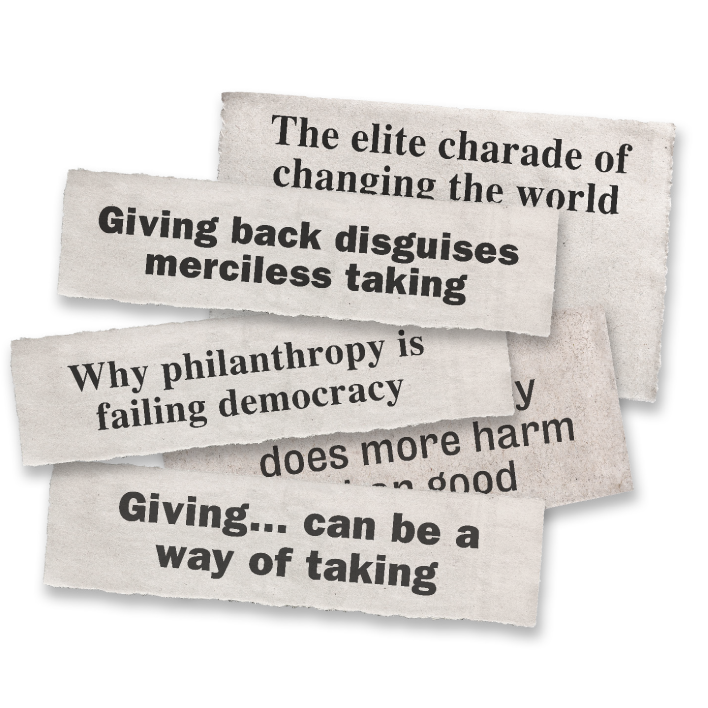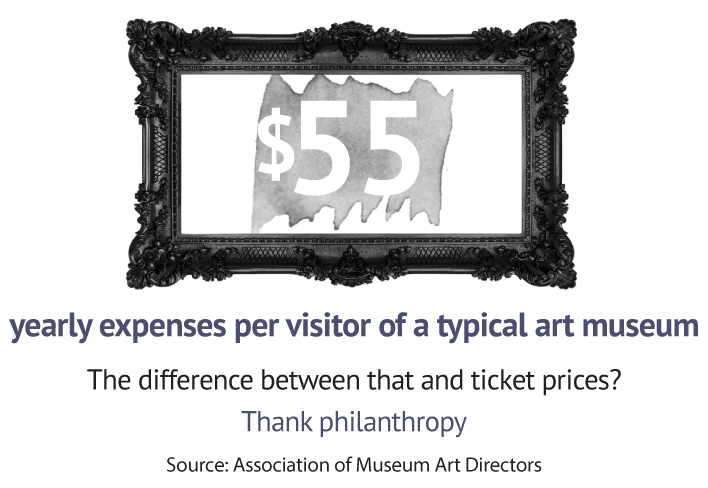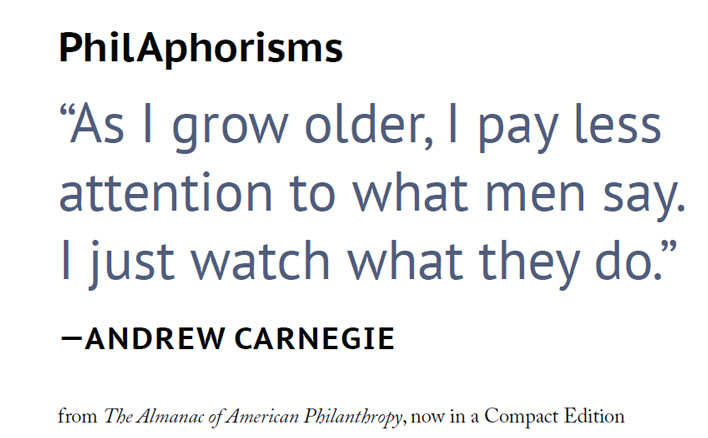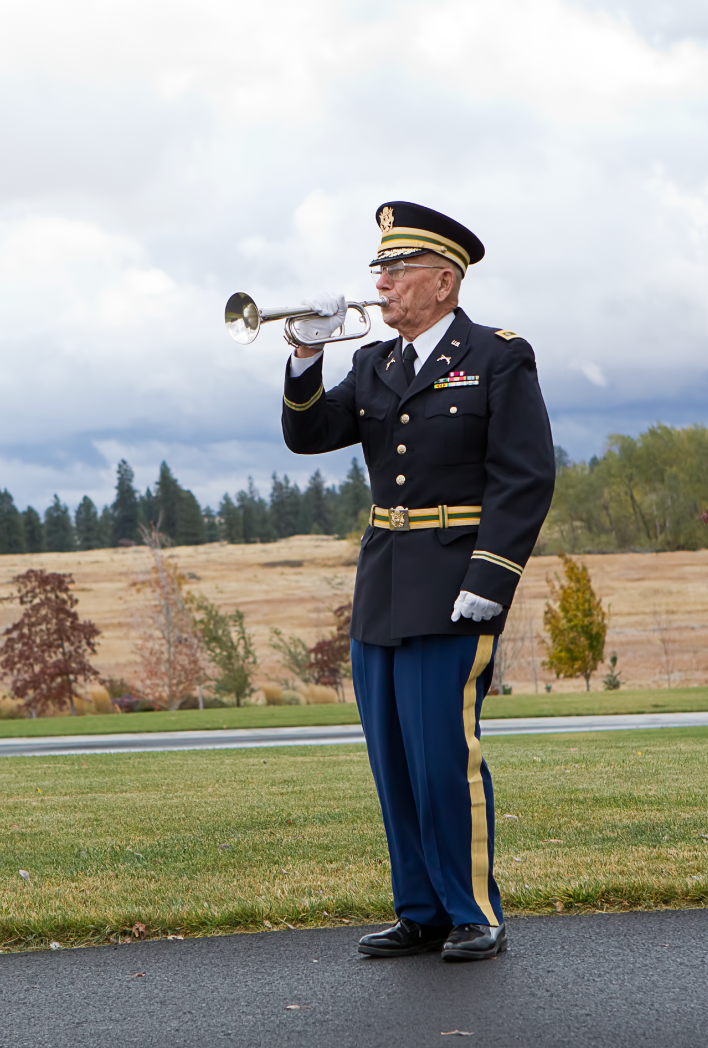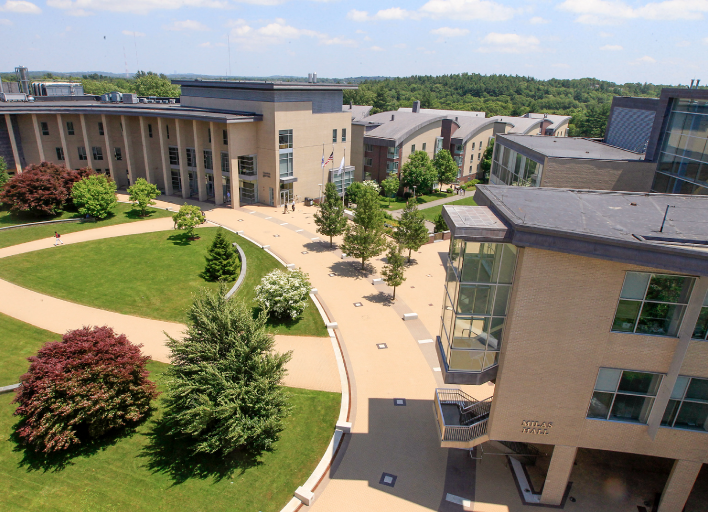The Assault on Generosity and Voluntary Action
“Around the turn of the last century, the steel magnate Andrew Carnegie paid to build 1,689 libraries across the United States. Many are still in use, celebrated as monumental works of philanthropy. They should be seen as monuments to the failure of public policy. The United States could have built a lot more libraries by taxing the incomes of Carnegie.”
Those were the words of the official editorial board of the New York Times in a high-profile May 2019 screed. That’s an especially visible and flagrant example of attempts to derogate and rewrite America’s remarkable history of mutual support and social improvement through the voluntary action of civil society.
But this thrust by the Gray Lady is just one of hundreds of recent jabs into the face of philanthropy. Every few months now there is a new guru out on book tour, savaging the motives, effects, and humanity of some of our most generous voluntary givers. Here are cover lines from some of the new works dumped on America over just the last year:
- “Giving back disguises merciless taking”
- “Why philanthropy is failing democracy”
- “The elite charade of changing the world”
- “Philanthropy does more harm than good”
- “Giving…can be a way of taking”
These themes are being endlessly repeated in media appearances and tut-tutting speeches, some of them delivered by men and women with 2020 political ambitions. The sages tell us that wealthy donors are secret oppressors, cynically laundering their reputations, distracting us with candy, blocking the rubes who make up the everyday public from seeing that our whole system is rigged, and our country manipulated by a rotten oligarchy. Who knew that second-guessing Americans who give away money could be a full-time job?
Tax records of the individuals making these same arguments while running for President show that few such thunderers donate much themselves. Person-to-person charity is too grubby an undertaking for high moralists busy kindling bonfires under red-eyed witches like Bill Gates, Robert Smith, David Koch, Michael Bloomberg, and Mark Zuckerberg.
Journalists anoint these righteous fulminators with citations in their news stories, offering no facts or perspective on what really happens in American civil society. So we never hear that philanthropy both large and small has been hugely important in rescuing foster children, aiding the homeless, accelerating medical research, creating today’s greatest urban parks. No one mentions (or even realizes) that donors voluntarily give far more to the poorest of the poor overseas than all of our government aid put together. Americans are left utterly unaware that the two greatest public amenities in New York City—the public library system and Central Park—are neither one managed by government, but rather run by charitable entities. How many stories have you read pointing out that the best schools boosting up minority kids in the U.S. today are all donor-initiated and donor-supported?
Facts like those are nowhere to be seen in what passes for journalism these days. Much more fun to jump into the echo chamber and attack the decency of Gates and honesty of Koch on Twitter.
Most of the journalists and editors handing microphones to haters of private giving like Anand Giridharadas have no idea how fundamentally inaccurate his cartoon villainizations are. They’re too ignorant about the daily operations of our philanthropic sector to recognize his malpractice. Embracing today’s excoriators is also easy because so much of the media now share kneejerk left-wing antipathies toward businessmen, wealth, religious injunctions to charity, person-to-person aid, civic localism, and other pillars of our culture of giving.
Columnist David Brooks recently noted that journalists refuse to “define local social repair and community-building as news.” It seems “too goody goody, too ‘worthy,’ too sincere. It won’t attract eyeballs.” Personal pummelings, claims of “billionaire boys club” conspiracies, cynical scoffing at generous gifts, reviling of successful citizens—these get the clicks that propel modern journalism.
Those reflexes, however, obscure truth. Spontaneous problem-solving through private giving is a profoundly American invention, and crucial to keeping our culture and economy strong. Brooks, who is better informed than the anti-philanthropy crowd, calls voluntary action “the central feature of American life.” Yet the media “barely cover” it. This leaves journalists blind to our country’s “most important social change agents.” Today’s national narrative, he warns, is controlled by people who are obsessed with politics, while “the 90 percent of our lives” dependent upon civil society is blacked out. That makes it easy for the distortionists to tell fables and fibs about philanthropy and mutual aid.
Alexis de Tocqueville considered America’s tradition of citizen initiative to reform and repair communities without resort to impersonal, bureaucratic, coercive mechanisms of government to be the most original and valuable creation of our new civilization. That priceless American innovation is now under ferocious, concerted, coordinated attack. Enemies of private giving and voluntary action are insisting that only government should be allowed to improve the common good, and that alternatives to state power must be shut down, or taxed away.
If you haven’t already realized all of this, it’s time to wake up. And punch back. —Karl Zinsmeister
Philanthropy Sets the Table for Science Breakthroughs
This spring, humans viewed something for the very first time: a black hole. The Event Horizon Telescope, a collaboration of more than 200 researchers who combined images from eight telescopes around the world, released a composite never before glimpsed, along with six papers in The Astrophysical Journal Letters. They documented the existence of something that had previously only been theorized about: a super-dense black hole, this one located 55 million light-years from Earth, with a mass 6.5 billion times that of the Sun. The result of decades of work, it was a giant achievement in astrophysics. And it was a fruit of philanthropy.
Scientific work that unfolds over many years, involving sprawling teams, who change course as they learn more about their undertaking, is often difficult to fund. These kinds of amorphous investigations rarely earn government grants. So private donors have filled that gap over many generations. Most of the flexible long-term grants to create breakthrough telescopes, for instance, were funded by donors ranging from Rockefeller to Carnegie to Keck to Moore.
An image of a black hole, brought to you by patient philanthropy.
In the hunt to image black holes, the John Templeton Foundation was a crucial backer. With their longstanding interest in “advancing human well-being by supporting research on the Big Questions,” Templeton created the world’s first center for the study of black holes with a $7.2 million grant to Harvard University in 2016. The Black Hole Initiative brought to bear an unusual mix of problem-solving tools, combining “observation, theory, mathematics, and philosophy of the universe’s mysterious objects.” The result was more than 50 research papers on black holes, and then eventually the first image of these enigmas.
Another example of long-term, risk-tolerant science philanthropy was announced in May. James Simons and Russ Carson (who will receive the William E. Simon Prize at The Philanthropy Roundtable annual meeting this year) announced a joint gift of $125 million to the New York Genome Center—an unusual collaborative that uses donor funding to pull several competing research centers in Manhattan into information sharing and cooperation in order to speed medical discovery. The same donors previously gave $100 million to the center, and jointly helped set the organization on its feet back in 2011. They were inspired by the model of Boston’s Broad Institute, another hugely productive science collaborative put into motion by donor Eli Broad.
May brought several other donations with potential to spark breakthroughs in science. A $100 million commitment from the Pritzker Foundation created at the University of Chicago the first school of molecular engineering in the U.S. And $150 million from the Stavros Niarchos Foundation and David Rockefeller created a new campus at medical powerhouse Rockefeller University. Built in two acres of airspace over busy FDR Drive on New York’s east side, it will accommodate 600 scientists in advanced new labs. This is how private giving sets the table for scientific feasts.
Homeless Tragedy and Farce
“A city with less than a million people spending more than $2 billion per year on ‘mental health’ and still their streets are littered with people desperately in need of care. Meanwhile, their leaders dither over a response that would require someone to be picked up by police eight times in a year before they could be helped involuntarily. Ridiculous.”
That is the director of a major mental-health advocacy nonprofit commenting to Philanthropy on the explosion of mentally ill and drug-addicted people on the streets of San Francisco today.
The response he refers to was just passed by the city council. After endless debate, harsh protests, and stiff new taxes to provide additional city services, it establishes a new pilot program. This will allow about five persons per year (according to the City Department of Public Health) to be involuntarily detained for treatment of their illness, with a court-appointed advocate supervising their case.
Meanwhile, the number of violent, ill, or delusional homeless persons detained by the police less than eight times in one year in San Francisco now numbers in the thousands and they are untouchable.
Taps For All
There are few successions of 24 notes that evoke the same mix of melancholy and uplift as “Taps.” In 2000, Congress passed Public Law 106-65 requiring that every eligible veteran receive a funeral in which the United States flag is presented and “Taps” is played.
Volunteer buglers play Taps to honor the fallen.
Our military employed only 500 buglers at the time, however, so recorded renditions of the song often had to be sent instead of live players. Tom Day, who had been a bugler in the Marines in the 1950s, felt his fellow veterans deserved better. “I call it stolen dignity that these veterans can’t get live Taps,” he said.
In response, Day recruited 400 volunteer horn players and founded Bugles Across America. Today, the organization has 4,000 volunteer buglers in all 50 states, each of whom has passed an audition. As often as possible, players supply their own instruments, though the organization has provided more than 700 donated horns to buglers who need them. Families seeking a bugler need only visit the organization’s website and a message is sent to all horn players within a 100-mile radius.
Since 2000, BAA has conducted over 250,000 military funerals, and its members have volunteered more than two million hours of their time to America’s veterans and their families. BAA is run entirely on donations. Every year since its founding, Day has made up any deficits himself. “The kisses, the handshakes from these families…no amount of money could ever buy the feeling that I get.” Day hopes to continue this mission for the rest of his life and leave the organization in solid shape to carry on for years to come. —Bethany Fefelov
Another Progressive Attack on School Reform
In May, the board of the Houston Independent School District voted to not renew the district’s contract with Teach For America, ending a partnership set in place since 1991. Houston was once a hotbed of TFA activity. There are 1,700 alumni in the Houston area, of whom 478 are still teachers, and 44 school leaders, including several in high administrative positions. Mike Feinberg and Dave Levin co-founded the high-performing KIPP schools in Houston as TFA alums, and Chris Barbic, founder of YES Prep and now superintendent of the Achievement School District in Nashville, Tennessee, was also a product of TFA in Houston.
But as part of the backlash led by unions and political liberals against TFA, school choices, and school reform, the number of new TFA teacher placements in Houston’s public schools had shrunk to about 35 in recent years. School board member Elizabeth Santos was quoted by the Houston Chronicle complaining that Teach For America “deprofessionalizes teaching, increases turnover, and undermines union organization. We should not subsidize TFA.”
Board president Diana Davila, who had previously voted for the TFA partnership flipped her vote this year. The reason is unknown, though local observers note that she hopes to solidify support from the teachers’ union before the next election, when her opponent is expected to be a TFA alum.
Meanwhile, the Houston public schools are under threat of being taken over by the state for refusing to address failing schools. In 2015, the Texas legislature passed a state law requiring action by overseers if a public school fails state standards for five years or more. Their options include closing the school or handing it over to new managers. The penalty for refusing to follow those requirements is that the entire school board gets replaced. The Texas Education Agency could unseat all members at HISD this year if the board continues to refuse to take serious measures to fix its failing schools.
Houston has had ups and downs recently in civil society.
The Houston Chronicle has reported that “the board is mired in dysfunction and infighting,” including conflicts between black and Hispanic members. An editorial commenting on the board’s decision to boot TFA argued, “it serves no one to choke off a pipeline to talented educators motivated to make a difference.” Texas Governor Greg Abbott has called the leadership at HISD a “joke” and a “disaster.” He tweeted bluntly: “If ever there was a school board that needs to be taken over and reformed it’s HISD. Their students and parents deserve change.”
Recovery Managers
Well before Hurricane Harvey reached Houston in August 2017, it hurtled through Aransas County, Texas. The small coastal region endured 130 mile-per-hour winds, the strongest to hit the United States since 2005. The storm demolished 867 individual-family homes, and estimated damages neared $812 million for residences and $134 million for businesses. Tourism was devastated, and the county unemployment rate rocketed from 5.4 percent before the storm to 10.3 percent a month after.
The Sid W. Richardson Foundation in Fort Worth, Texas, stepped up to help. They hired two retired city managers and relocated them to Aransas so they could apply their experience to add a charitable lift to official recovery efforts. The managers arrived within 36 hours after being hired, and went to work navigating bureaucracies. “Federal disaster programs were not designed for small towns,” says Pete Geren, president of the foundation. “They’re complicated, they’re labor-intensive, and they’re bewildering.”
The seasoned managers began with debris removal, then assessed individual assistance needs, insurance claims, and FEMA payouts. They prioritized the tourism industry to restart the county’s economy. They tracked down affordable-housing options.
Twenty months after Harvey first made landfall, Aransas County has made tremendous strides. By April of 2019, the unemployment rate had dropped to 3.6 percent. While 88 percent of the county’s businesses were closed down by the storm, 93 percent are now open. An aquarium, the Key Allegro Bridge, and municipal buildings are being rebuilt.
The Sid Richardson Foundation’s quick earmarking of $250,000 to bring pros to the scene of a disaster and cut through red tape has had very large benefits. “It’s hard to imagine an investment with greater leverage than putting city managers on the ground helping these communities,” says Geren.
—Bethany Fefelov
A Creative Approach to Higher Ed
Franklin Olin was a classic American entrepreneur who became a generous philanthropist. Hundreds of millions of dollars of his family money was poured into higher education. Walk the campuses of many of America’s best universities, and you’ll find a total of 78 different Olin Halls spread across the country.
An engineering college for modern times.
But when Franklin’s foundation approached its sunsetting, the leaders decided to use the remaining funds to do something more creative. They would make a contribution to American education as unconventional, entrepreneurial, and inventive as Franklin Olin himself. In the mid-1990s, Olin’s foundation put up $200 million to design a brand-new college focused on one thing—teaching engineering to top students in a completely fresh way.
The founding president of the college, Richard Miller, explained why radically new approaches to training engineers were desperately needed:
Only 40 percent of the kids who start in engineering this fall will ever graduate. Six out of ten leave. And half of those who leave have higher grades than the ones who stayed. They’re not flunking out, they’re being driven out by the way we teach. It’s been called the math-science death march. We never let them touch a wrench until they’re already gone.
The Franklin Olin College of Engineering operates in ways that are dramatically different from other schools. It has no separate departments; everything is cross-disciplinary. It does not provide lifetime tenure to any of its professors. Writing, speaking, sketching, computer coding, data science, and persuasive skills are taught along with conventional math and science topics.
Instead of the usual heavy dose of note-taking lectures, students complete 20 to 30 major engineering projects while on campus. U.S. companies compete for the right to commission Olin students to solve real-life engineering problems, covering all expenses. College president Miller says that the goal is “entrepreneurial, creative, team players who envision what has never been, and do whatever it takes to make that happen.”
Students scramble to get into Olin. Only 16 percent of applicants are accepted. The school is able to provide merit scholarships to every student covering half of tuition expenses, thanks to the total of $460 million that the foundation gifted to establish the college.
Most Olin enrollees thrive. The school is a top producer of Fulbright Scholars and National Science Foundation fellows. Employers love Olin too. Starting salaries for graduates are one quarter higher than the national average.
Olin is a small school, enrolling only several hundred students in a given year. But it is having an outsized influence on education—because its successes have turned it into what President Miller calls “a privately funded national laboratory for technology education.”
The philanthropists who created Olin, Miller notes, didn’t want “another small school that provides a good education. There are lots of those.” Rather, he says, “Olin has a missionary focus” on its modernized, practical approach to teaching engineering.
More than a thousand educators from other schools have visited Olin since 2009, from around the U.S. and the world, to study its curriculum and approach. Some colleges have already remade themselves to mimic Olin’s breakthroughs. Donors like the Kern Family Foundation are helping spread this new gospel in engineering instruction to fresh territories.
America’s economy is suffering today from serious shortages of engineers. Too few young people enter the discipline, and too many who give it a try end up dropping out. The share of U.S. undergrads earning engineering degrees is now only 5 percent. In Europe, engineers are 12 percent of all college graduates; in Asia it’s 35 percent.
The remarkable college set up by the Franklin Olin Foundation is doing vastly better than others at both attracting and training young engineers. For instance, half of the engineering students at Olin are female; conventional colleges are lucky if they can draw in 20 percent. And Olin is twice as successful at getting engineering majors all the way to graduation. It’s a model that works. And it’s worth copying.
—Karl Zinsmeister
(For more stories like this, subscribe to the Sweet Charity podcast at SweetCharityPodcast.org)
